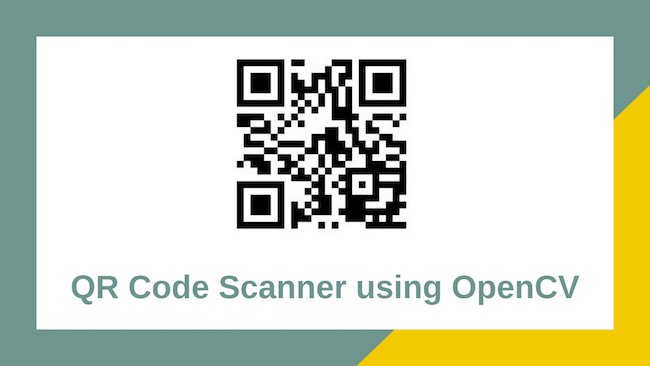Recently, OpenCV 4.0 was released with many improvements and new features. One of them is the QR code scanner. We had already written about Bar Code and QR code scanner in a previous post, which uses an external library – ZBar. So, we wanted to check how the OpenCV scanner works and if it is better than the Zbar one. In this post, we will see how to use this new QR code scanner from OpenCV. We will also compare it with the ZBar based scanner in case you want to chose which one to use.
OpenCV 3.4.4 on Windows / Ubuntu ,
OpenCV 4.0.0 on Windows / Ubuntu
QR Code Scanner in OpenCV
If you want to get more details on What exactly is a QR Code, I would suggest you visit the Wikipedia. Let’s just dive into the code for QR Code Detection. Please download the code from the link below. We have also provided code for comparing ZBar and OpenCV QR Code Detector in the download section.
C++ Code
First include the required header files
#include <opencv2/objdetect.hpp>
#include <opencv2/imgcodecs.hpp>
#include <opencv2/highgui/highgui.hpp>
#include <opencv2/imgproc/imgproc.hpp>
#include <iostream>
using namespace cv;
using namespace std;
Utility function to display the box around the detected QR Code
void display(Mat &im, Mat &bbox)
{
int n = bbox.rows;
for(int i = 0 ; i < n ; i++)
{
line(im, Point2i(bbox.at<float>(i,0),bbox.at<float>(i,1)), Point2i(bbox.at<float>((i+1) % n,0), bbox.at<float>((i+1) % n,1)), Scalar(255,0,0), 3);
}
imshow("Result", im);
}
In the main funcion, we first read the image. Then, we instantiate a QRCodeDetector Object and use the detectAndDecode method to find the data and the location of the QR Code. Finally, we display the results.
int main(int argc, char* argv[])
{
// Read image
Mat inputImage;
if(argc>1)
inputImage = imread(argv[1]);
else
inputImage = imread("qrcode-learnopencv.jpg");
QRCodeDetector qrDecoder = QRCodeDetector::QRCodeDetector();
Mat bbox, rectifiedImage;
std::string data = qrDecoder.detectAndDecode(inputImage, bbox, rectifiedImage);
if(data.length()>0)
{
cout << "Decoded Data : " << data << endl;
display(inputImage, bbox);
rectifiedImage.convertTo(rectifiedImage, CV_8UC3);
imshow("Rectified QRCode", rectifiedImage);
waitKey(0);
}
else
cout << "QR Code not detected" << endl;
}
Python Code
First import the modules
import cv2
import numpy as np
import sys
import time
Next, we read the input image, you can specify your own image from the command line
if len(sys.argv)>1:
inputImage = cv2.imread(sys.argv[1])
else:
inputImage = cv2.imread("qrcode-learnopencv.jpg")
Utility function to display the box around the QR Code
# Display barcode and QR code location
def display(im, bbox):
n = len(bbox)
for j in range(n):
cv2.line(im, tuple(bbox[j][0]), tuple(bbox[ (j+1) % n][0]), (255,0,0), 3)
# Display results
cv2.imshow("Results", im)
Create a QRCodeDetector Object and detect the code and its location using the detectAndDecode method.
qrDecoder = cv2.QRCodeDetector()
# Detect and decode the qrcode
data,bbox,rectifiedImage = qrDecoder.detectAndDecode(inputImage)
if len(data)>0:
print("Decoded Data : {}".format(data))
display(inputImage, bbox)
rectifiedImage = np.uint8(rectifiedImage);
cv2.imshow("Rectified QRCode", rectifiedImage);
else:
print("QR Code not detected")
cv2.imshow("Results", inputImage)
cv2.waitKey(0)
cv2.destroyAllWindows()
Output
The decoded data is shown on the Terminal and a bounding box is drawn around the detected QR Code.
Terminal Output
Time Taken for Detect and Decode : 0.044 seconds
Decoded Data : https://learnopencv.com
Comparison
Now, let us compare the two implementations on the following grounds. Surprisingly, ZBar based scanner outperforms OpenCV’s QR Code in all aspects.
Speed
The ZBar library is almost twice as fast as the OpenCV QR code detector.
Robustness
The ZBar library produces more robust results as compared to OpenCV on the following factors as shown in the above video :
- ZBar is better or comparable at various rotation
- ZBar is better at different image sizes as seen from the different zoom levels in the video
- ZBar is better at handling perspective distortions ( when the image is not upright w.r.t the camera.
Features
The ZBar library provides support for Bar codes as well, which is not yet there in OpenCV.
Overall, we can say that QR Code is launched recently in OpenCV and it might get better in future releases. Till then, if you want to use Bar code or QR Code in your application, stick with ZBar.







